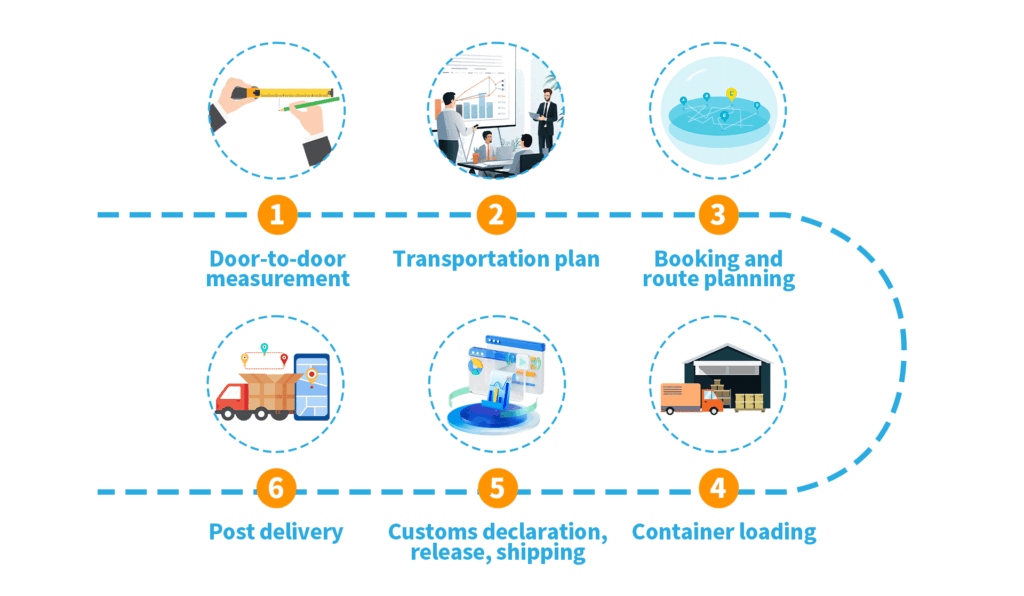The transportation of oversized and high-value goods is an extremely complex and highly specialized task that demands rigorous operating procedures, professional handling, and seamless coordination. Each stage must be executed with precision to guarantee both the safety of the cargo and the timeliness of delivery. Below is a comprehensive overview of the general process involved in oversized and expensive cargo transportation, which includes door-to-door measurement, transportation planning, booking and pre-arrangements, loading, customs declaration, release, and post-delivery services.

1. Door-to-Door Cargo Measurement
The very first step in transporting oversized and costly cargo is an on-site measurement of the cargo. Professional measurement specialists will visit the cargo’s location to record accurate data regarding its length, width, height, and weight. This process is especially critical, as oversized cargo frequently involves goods that exceed standard dimensions or weight restrictions, such as overlength, overwidth, overheight, or overweight items. The precision of this measurement directly determines the feasibility, safety, and cost-effectiveness of the subsequent transportation plan.
2. Transportation Planning
Based on the verified measurement results, the transportation company develops a detailed and customized transportation plan. This plan encompasses the selection of appropriate container types (such as open-top containers, flat racks, or specialized equipment) as well as the loading methodology. To ensure maximum safety and efficiency, logistics providers often utilize 3D loading simulation technology, which allows them to model the loading process in advance. This not only optimizes cargo placement and securing methods but also maximizes space utilization while minimizing risks, ensuring that the goods remain stable and protected throughout the journey.
3. Booking and Preliminary Preparation
Once the transportation plan has been finalized, the next stage is booking and preparing for shipment. Booking involves securing space on the designated vessel, aircraft, or other transportation modes, ensuring timely dispatch of the cargo. Concurrently, the logistics company will carefully plan the trailer route, selecting the safest and most efficient option. Pre-loading preparations typically include photographing the cargo to document its condition and arranging auxiliary materials such as lashing straps, wooden blocks, and protective pads. These preparations are vital to guaranteeing a smooth and controlled loading process.
4. Loading
Loading represents the most critical and technically demanding stage in oversized and expensive cargo transportation. Depending on the cargo’s dimensions and structural requirements, the logistics company will select specialized trailers, such as ultra-low flatbed trailers. During the loading procedure, experienced operators will securely fasten the cargo using professional lashing and fixing techniques. When required, additional protective measures—such as wooden crate packaging, steel framing, or vacuum-sealed wrapping—may be employed. These safeguards not only prevent cargo movement and potential damage during transit but also significantly enhance the overall safety and stability of the transportation process.
5. Customs Declaration and Release
Following loading, the cargo must undergo customs declaration. This involves submitting detailed information about the shipment—such as type, quantity, weight, and declared value—to the customs authorities to obtain official clearance. This stage requires the preparation of comprehensive documentation, and the accuracy and consistency of all submitted data are crucial to avoiding delays or penalties. Upon successful clearance and the issuance of a release permit, the cargo is authorized for export or onward shipping to its destination.
6. DAP and DDP Post-Delivery Services
Once the cargo arrives at its destination country, the transportation company provides post-delivery services under DAP (Delivered At Place) or DDP (Delivered Duty Paid) terms, depending on customer requirements. Under DAP, the cargo is delivered to the designated location but unloading and duties are excluded, while under DDP, the logistics provider assumes responsibility for all unloading, duty payments, and related fees until final delivery is completed. These services usually involve cargo retrieval from the port or airport, followed by last-mile delivery via road or rail. By offering comprehensive end-to-end solutions, the transportation company ensures that even oversized and high-value cargo reaches its final destination safely, intact, and on schedule.
